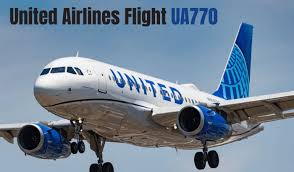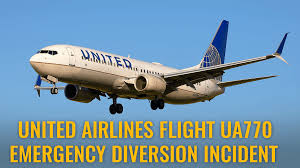
Hey there, aviation enthusiasts and curious travelers! If you’ve been scrolling through the news lately, you’ve probably stumbled across the buzz around the United Airlines Flight UA770 Emergency Diversion. It’s one of those stories that grabs your attention—mid-flight drama, a quick pivot to safety, and a reminder of how complex air travel can be.
I’ll be honest: when I first heard about it, I was glued to my phone, wondering what went down up there at 37,000 feet. Spoiler alert—it’s not as scary as it sounds, but it’s definitely worth digging into.
This incident, which unfolded on May 27, 2025, involved a United Airlines Boeing 787-9 Dreamliner veering off course from its Barcelona-to-Chicago route to land safely at London Heathrow. The crew declared a general emergency with a Squawk 7700 code, and the whole operation was handled like a well-rehearsed dance.
As someone who’s fascinated by how airlines manage these situations, I wanted to break it all down for you—why it happened, how it was handled, and what it means for flyers like us in 2025. So, grab a coffee, and let’s dive into the full story of the United Airlines Flight UA770 Emergency Diversion!
What Happened During the United Airlines Flight UA770 Emergency Diversion?

Let’s start at the beginning. On May 27, 2025, United Airlines Flight UA770 took off from Barcelona El Prat Airport, bound for Chicago O’Hare with 289 passengers and crew on board.
The plane, a Boeing 787-9 registered as N26902, was cruising smoothly at 37,000 feet when, about 90 minutes into the flight, something went off-script. The crew detected a technical anomaly—initial reports point to a cabin pressurization issue or electrical system warning—and made the call to divert to London Heathrow.
Now, if you’re like me, your heart might skip a beat hearing “emergency diversion.” But here’s the cool part: this is where aviation safety shines. The pilots activated Squawk 7700, a universal signal that tells air traffic control (ATC) across Europe to clear the way and prioritize the flight.
By 4:55 PM BST, the plane touched down safely on Runway 27R, and passengers were soon deplaned at Gate B44 after a brief stopover. No injuries, no chaos—just a textbook example of how training and technology work together.What caused this hiccup?
While investigations are ongoing (more on that later), early whispers suggest it could be a pressurization glitch or an electrical alert—common enough issues that don’t always spell disaster but always trigger a cautious response. The crew’s quick thinking turned a potential problem into a non-event, and that’s the story we’re unpacking today.
The Timeline: How It All Unfolded
To really get a grip on the United Airlines Flight UA770 Emergency Diversion, let’s walk through the timeline. It’s like piecing together a puzzle, and I love a good story with a happy ending!
- Takeoff: The flight departed Barcelona at 2:30 PM CEST, a routine transatlantic hop with clear skies ahead.
- The Alert: Around 4:00 PM CEST (90 minutes in), the cockpit crew noticed the anomaly. They didn’t panic—they assessed, communicated, and acted.
- Squawk 7700: This code was activated, alerting ATC centers in London, Paris, and Madrid. Within minutes, a safe path to Heathrow was coordinated.
- Diversion Decision: London Heathrow was chosen for its proximity (about 1,000 miles from the flight’s position) and top-notch emergency facilities.
- Landing: The plane landed at 4:55 PM BST, greeted by fire trucks and medical teams as a precaution. Passengers described it as smooth, almost routine.
- Aftermath: After a one-hour stopover, the aircraft moved to Gate B44. United rebooked passengers, handed out vouchers, and kept the mood calm.
Passengers took to social media, with some posting pics of the tarmac and praising the crew’s composure. One traveler tweeted, “Scary moment, but the crew kept us chill—total pros!” It’s moments like these that remind us how aviation pros turn potential drama into a non-story.
Why Did They Divert? Common Reasons for Emergency Landings
So, why did United Airlines Flight UA770 need to divert? Emergency landings aren’t everyday occurrences, but they happen more often than you’d think. Let’s break down the usual suspects—some of which might apply here:
- Technical Failures: Electrical issues or sensor glitches, like the ones hinted at for UA770, can prompt a diversion. Safety first, always.
- Cabin Pressurization Problems: A drop in cabin pressure (possibly UA770’s culprit) requires an immediate descent to a breathable altitude and a nearby airport.
- Weather Disruptions: Storms or turbulence can force a reroute, though this wasn’t the case here with clear skies reported.
- Medical Emergencies: If a passenger needs urgent care, the closest airport becomes the new destination. No such reports for UA770.
- Security Issues: Unruly passengers or threats can trigger a diversion, but this flight seemed incident-free on that front.
For UA770, the leading theory is a cabin pressurization issue or electrical warning—minor in isolation but serious enough to warrant caution. The Boeing 787-9’s advanced systems likely flagged it early, giving the crew time to react. It’s a reminder that these diversions are often preventative, not reactive, which is why no one was hurt.
The Crew’s Heroic Response: Inside the Cockpit and Cabin

Let’s give a shoutout to the real MVPs—the crew of United Airlines Flight UA770. These folks turned a tense situation into a smooth landing, and their training was on full display.
- Pilots’ Checklist: Once the anomaly popped up, the pilots followed a strict protocol—assess the risk, notify ATC, calculate fuel, and pick a diversion airport. Heathrow’s long runways and United’s hub status made it a no-brainer.
- Cabin Crew’s Role: Flight attendants kept passengers informed with calm updates, walked the aisles to reassure worried faces, and prepped for a potential emergency landing. Their professionalism kept panic at bay.
- Ground Coordination: ATC in multiple countries synced up, and Heathrow’s emergency services were ready on the tarmac. It’s like a live-action team effort!
Passengers noted the crew’s cool-headedness. One said, “They told us exactly what was happening—no sugarcoating, just facts. Made all the difference.” This level of communication is gold in aviation, and it’s why UA770’s story ends with a safe landing, not a headline disaster.
Passenger Experience: What It Was Like Onboard
Imagine you’re 37,000 feet up, sipping your in-flight coffee, when the captain announces a diversion. That’s what happened to the 289 souls on United Airlines Flight UA770. Here’s what it felt like, based on passenger accounts and expert insights:
- In-Flight Vibe: Tension was palpable but controlled. Some passengers clutched their armrests, others peeked out windows, but the crew’s steady updates—“We’re diverting to Heathrow for a technical check”—kept things orderly.
- Emotional Rollercoaster: Fear mixed with curiosity. One passenger recalled, “My heart raced, but seeing the crew so calm helped me relax.” Phones came out, snapping pics of the horizon as the plane descended.
- Landing and After: The touchdown was smooth, met by flashing lights from emergency vehicles. On the ground, United agents handed out vouchers, rebooked flights, and even offered hotel stays for those with long delays.
It wasn’t a movie-style panic—more like a collective holding of breath, followed by relief. United’s quick response with snacks, rebooking, and $200 travel credits for some passengers turned a stressful day into a manageable inconvenience.
United’s Response: How They Handled the Fallout

United Airlines didn’t just land the plane and call it a day—they stepped up post-diversion. Here’s how they managed the United Airlines Flight UA770 Emergency Diversion aftermath:
- Official Statement: “Flight UA770 diverted to Heathrow out of an abundance of caution following a technical alert. The aircraft landed safely, and passengers were re-accommodated.” Short, sweet, and reassuring.
- Passenger Support: Agents in Heathrow prioritized rebooking, ensured luggage followed passengers, and distributed meal vouchers. Some received travel credits as a goodwill gesture.
- Media Handling: While mainstream news gave it moderate coverage, social media buzz praised United’s professionalism, contrasting it with past PR flops. The airline’s transparency helped quell outrage.
This response shows United’s commitment to safety and customer care, turning a potential PR headache into a showcase of their protocols.
The Investigation: What’s Next for UA770?
The United Airlines Flight UA770 Emergency Diversion isn’t fully closed yet. The FAA and EASA (European Union Aviation Safety Agency) are digging into the cause, and here’s what that means:
- What They’re Looking At: Flight recorders, cockpit voice recordings, and maintenance logs are under review. The goal? Pinpoint the exact issue—pressurization, electrical, or something else.
- Possible Outcomes: If it’s a recurring glitch (say, a sensor fault), we might see safety bulletins or software updates for the Boeing 787-9. If it’s a one-off, it’ll still inform future training.
- Timeline: Investigations can take months, but initial findings might drop by late 2025, given the complexity of transatlantic flights.
This process is standard and ensures every diversion makes air travel safer. For now, it’s a waiting game, but the lack of injuries keeps the stakes low.
Lessons Learned: What This Means for Aviation Safety
The United Airlines Flight UA770 Emergency Diversion is more than a news blip—it’s a case study in aviation excellence. Here’s what we can take away:
- Crew Training Pays Off: The pilots’ and cabin crew’s composure under pressure is a testament to rigorous training. It’s not just about flying the plane—it’s about managing people too.
- Technology’s Role: The 787-9’s real-time diagnostics and Squawk 7700 system turned a potential issue into a controlled response. Redundant systems are a game-changer.
- Passenger Trust: Transparency and quick action rebuild confidence. United’s handling shows airlines can turn crises into trust-building moments.
- Preventing Repeat Incidents: Post-investigation tweaks—whether software patches or procedure updates—will make future flights even safer.
Aviation’s safety record is stellar (fewer than 1 fatal accident per million flights globally), and UA770 reinforces why. It’s not about avoiding emergencies but mastering them.
A Separate Incident: UA770 Diverts to Denver

Hold on—there’s a twist! Another United Airlines Flight UA770 Emergency Diversion hit the news, this time on a domestic route. On August 5, 2025, a Boeing 737-800 en route from Los Angeles to Chicago diverted to Denver due to electrical system irregularities. Sound familiar? Here’s the rundown:
- Details: The flight landed safely, with no injuries. Passengers were rebooked, and United cited “abundance of caution” again.
- Differences: This was a domestic leg, not transatlantic, and involved a different aircraft type. The cause might align with the London case, though.
- Impact: It’s a rare coincidence—same flight number, different days, similar outcomes. It highlights how routine these diversions can be when handled right.
Two UA770 incidents in months? It’s a fluke, not a pattern, but it’s fueling chatter about United’s fleet maintenance. Investigations will clarify, but for now, it’s another win for safety protocols.
Why This Matters for Travelers in 2025
So, what does the United Airlines Flight UA770 Emergency Diversion mean for you, the traveler? In 2025, air travel is safer than ever, but incidents like this remind us of the human and tech factors at play. Here’s why it’s relevant:
- Safety Confidence: Seeing how crews and systems handle diversions boosts trust. You’re in good hands, even when plans change.
- Preparation Tips: Listen to safety briefings, stay calm, and leave luggage behind during evacuations. UA770’s smooth landing shows why this matters.
- Tracking Tools: Apps like FlightRadar24 let you follow flights in real-time, offering peace of mind if you’re on a United plane.
- Industry Evolution: Ongoing investigations will refine safety, making your next flight even smoother.
This isn’t a scare tactic—it’s a celebration of how far aviation has come. Your next trip might just benefit from UA770’s lessons.
Conclusion: A Triumph, Not a Tragedy
The United Airlines Flight UA770 Emergency Diversion could’ve been a headline horror, but it turned into a triumph of safety and professionalism. From the crew’s quick decision to divert, to the seamless coordination with ATC, to United’s passenger care, it’s a story of systems working as designed.
Whether it was a pressurization hiccup or an electrical glitch, the outcome was zero injuries and a safe landing—proof that aviation’s safety net holds strong.If you’re flying soon, take heart in this. And if you’re curious about your flight’s status, check United’s app or FlightRadar24. The skies are safer because of moments like UA770. Ready to book your next trip with confidence? Let’s keep exploring the world—one safe flight at a time!
FAQ: Your Burning Questions Answered
Q: What caused the United Airlines Flight UA770 Emergency Diversion?
A: Early reports suggest a cabin pressurization issue or electrical system alert, though the FAA and EASA are still investigating. Safety drove the decision to divert.
Q: Were there any injuries during the diversion?
A: No, all 289 passengers and crew landed safely at Heathrow with no reported injuries. Emergency services were on standby but not needed.
Q: How did the crew handle the situation?
A: The pilots and cabin crew stayed calm, followed protocols, and kept passengers informed, earning praise for their professionalism.
Q: Did passengers get compensation?
A: Yes, many received $200 travel credits, rebooking, and vouchers for meals or hotels, depending on their delay.
Q: How long was the delay?
A: The stopover was about one hour at Heathrow, with rebooking adding variable delays based on passenger schedules.
Q: Has United commented publicly?
A: Yes, they confirmed the diversion was precautionary due to a technical alert, emphasizing passenger safety.
Q: What happens to the plane after a diversion?
A: It undergoes a thorough inspection and maintenance check before returning to service, pending investigation results.
Q: Is it common for flights to divert mid-air?
A: Yes, diversions happen several times a week globally for various reasons, though most are routine and safe.
Q: Can passengers track diversions in real-time?
A: Absolutely—tools like FlightRadar24 provide live updates on flight paths and diversions.
Q: Should I worry about flying after this?
A: Not at all. This incident shows safety systems work, and air travel remains one of the safest modes of transport.





